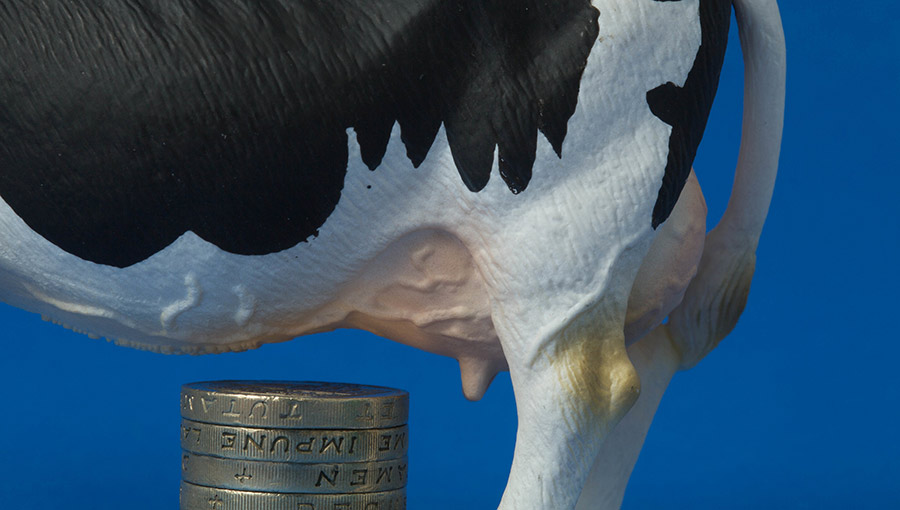Top tips on dealing with tight cashflow as dairy margins tighten
 © Tim Scrivener
© Tim Scrivener With input costs rising and a number of milk processors announcing cuts to farmgate prices, dairy farm margins are being squeezed yet again.
Many producers will be hoping there won’t be a flush of spring milk to add to their woes, with some processors already at limit for capacity after record milk sales for December.
We spoke to farm business consultants and banks at Dairy-Tech, Stoneleigh, on (6 February), to get some advice on how businesses can manage ever-tightening cashflows.
Before you do your budget, analyse your business performance
Go through your accounts and analyse them.
Andersons partner and head of business consultancy Tony Evans says the aim should be to spend one-third on variable costs (such as feed and labour), one-third on overheads (fixed costs such labour, power and machinery) and one-third should be left over for rent and finance.
See also: 5-step guide to preparing a budget for your dairy farm
“Straight away you can see where you are strong or weak,” he says.
Take-home messages:
- Don’t look at one year in isolation. Take accounts from the last two to three years
- Analyse business performance and identify areas of weakness.
Prepare a budget and monitor cashflow
Every farm must prepare a budget and monitor cashflow at least quarterly to be able to understand what’s happening to cash within the business.
This will help businesses understand where demands are on cash and evaluate why and what could be done to mitigate this.
In some instances, there may be a good reason that cashflow is tight, says Kite Consulting’s Helen Evans.
She says to consider why cashflow could be restricted. Is it because the business is performing badly or is it because you’ve grown the business?
“The thing to understand is why you have cashflow pressure. If you have grown the herd then cashflow is a poor measure of business performance,” says Mrs Evans.
“It’s about understanding that total picture and talking to your bank. If you need to increase the overdraft because you’ve grown that herd, it’s different to if your milk sales are down,” she adds.
Take-home messages:
- Prepare a budget
- Review it regularly – at least quarterly
- Check what is causing cashflow pressure.
Speak to your creditors and the bank early on
Don’t be blind to the situation; know what price increases or decreases are going to do to your business because without that you can’t talk to the bank about cashflow, advises Barclay’s Oliver McEntyre.
And if you do foresee a problem, speak to your creditors early on and try and arrange payment plans, says Mrs Evans.
Take-home messages:
- Ensure you have the right flexibility in place for the next 12-month trading period such as overdraft and working capital
- Talk to your bank early if you think you need more money
- The bank will need to see your last three years’ accounts and your budget.
Manage risks by forward-buying commodities
Feed prices can account for 30-35% of costs so farmers should take cover to manage this risk by fixing feed and fertiliser.
“We feel feed is more likely to go up than come down because of global supply and demand,” warns Kite consultant Chris Flint.
“At the moment there’s quite a lot of wheat in the world but a huge amount of that is in China and won’t be traded on the market, so in actual stock terms we are at a historic low and with increasing demand we would expect prices to go up.”
Take-home messages:
- Ask your supplier for forward prices
- Shop around and scour the internet for trends
- Forward fix prices to give you cover, at least into the summer.
Finance
For exposed businesses with borrowings, finance is a ‘biggy’, according to Mr Flint.
He says there are good fixed-interest deals to be had and farmers should shop around for the best rates.
“If a business is borrowing quite a lot of money and interest rates shot up 3% that could cause quite a lot of damage. You need to build resilience into the business because we are in a volatile era.”
Take-home messages:
- If borrowing money, fix the interest rate
- Shop around for the best deals.
Join a discussion group
Benchmark your performance against others, find out who is doing better than you are and see what they are doing that you aren’t.
Take-home messages:
- Benchmark your figures against other like-minded businesses
- Identify areas to improve.
Don’t unnecessarily increase investment
If you are not increasing business output then don’t increase your investment, warns Mr Evans.
“If you’re replacing a 150hp tractor don’t buy a 160hp tractor and increase your running costs if it’s going to do the same job. Your depreciation will go up and return on capital will go down.”
Take-home messages:
- Don’t over-capitalise your business and spend more than you need
Don’t carry any passengers
If you are carrying excess replacements can you sell them to bring in some cash? This will also reduce pressure on feed and housing costs, says LIC pasture to profit consultant Sean Chubb.
Cows that are underperforming should also be cashed in.
Take-home messages:
- Look if you can reduce stock numbers by selling surplus stock or underperforming animals.
